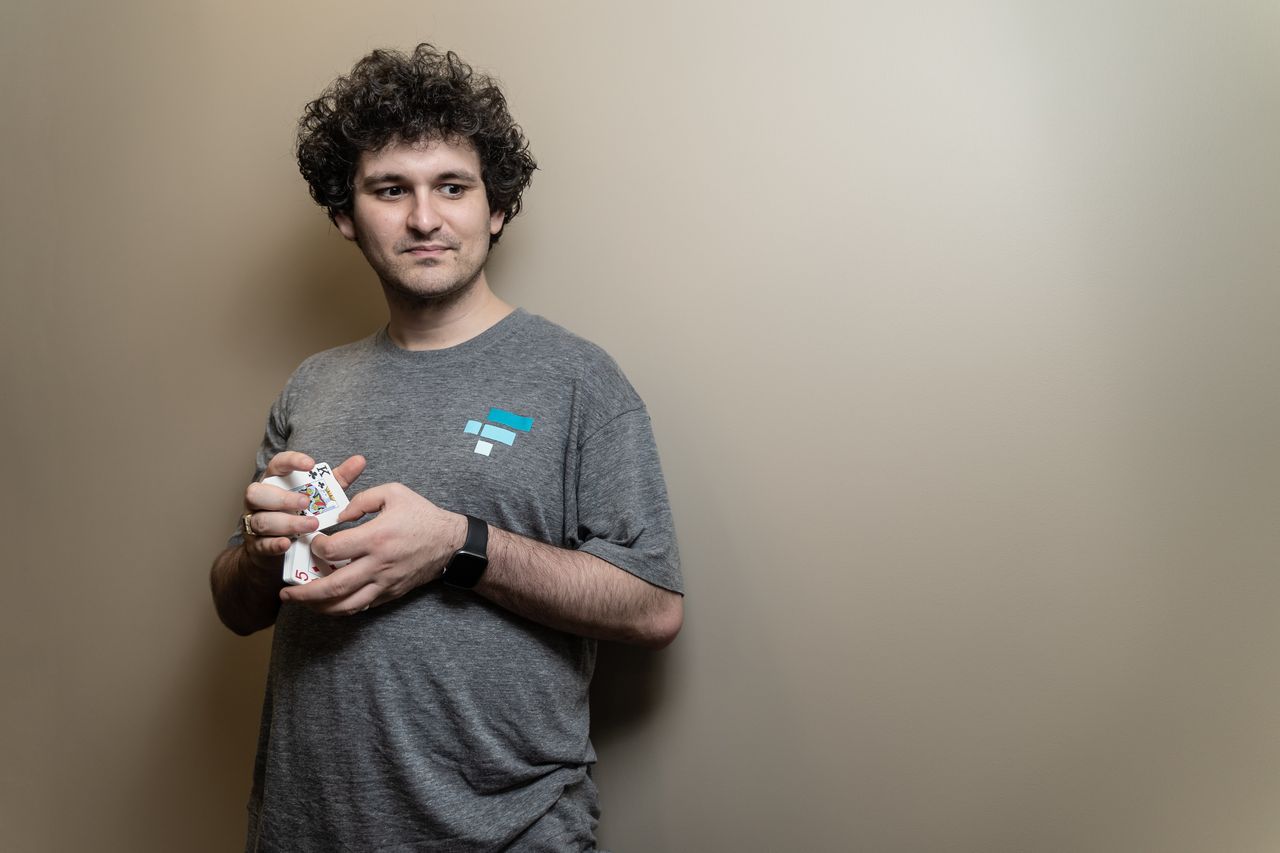FTX’s Sam Bankman-Fried Charged With Criminal Fraud, Conspiracy
The charges are the latest twist in a saga that has rattled the world of cryptocurrencies
U.S. prosecutors on Tuesday charged FTX founder Sam Bankman-Fried with eight counts of fraud and conspiracy, in what they called a scheme to defraud his crypto exchange’s customers and his hedge fund’s lenders.
An indictment by the U.S. attorney’s office for the Southern District of New York, unsealed Tuesday morning, accuses him of misappropriating FTX.com customers’ deposits and using those to pay expenses and debts of Alameda Research, his crypto hedge fund. Mr. Bankman-Fried is charged as well with defrauding the U.S. and violating campaign finance rules for conspiring with others to make illegal political contributions.
The FTX collapse is “one of the biggest financial frauds in American history,” said Damian Williams, the U.S. attorney for the Southern District of New York, at a press conference Tuesday afternoon.
Separately, John J. Ray III, the new chief executive of FTX, said at a congressional hearing Tuesday that FTX has incurred losses “in excess of $7 billion.” Mr. Ray, who oversaw the Enron Corp. bankruptcy in the early 2000s, said funds were taken from FTX and misused by affiliated trading firm Alameda Research, which incurred trading losses.
Mr. Ray described Enron as having been brought down by sophisticated people whose machinations aimed to keep transactions secret. FTX, by contrast, presents as “old-fashioned embezzlement,” Mr. Ray said. “It’s taking money from customers and using it for your own purpose.”
Also Tuesday, the Securities and Exchange Commission alleged in a civil lawsuit that Mr. Bankman-Fried diverted customer funds from the start of FTX to support Alameda and to make venture investments, real-estate purchases and political donations. Another U.S. markets regulator, the Commodity Futures Trading Commission, filed a separate lawsuit Tuesday linking his alleged fraudulent conduct at Alameda and FTX to markets that the CFTC regulates.
“Sam Bankman-Fried built a house of cards on a foundation of deception while telling investors that it was one of the safest buildings in crypto,” SEC Chair Gary Gensler said in a statement.
The charges are the latest twist in a saga that has rattled the world of cryptocurrencies, a largely unregulated market that boomed during the pandemic stimulus period but has been hammered this year by rising interest rates and the failure of several significant industry players.
FTX, one of the largest crypto exchanges in the world, filed for bankruptcy last month after the firm ran out of cash and a hastily arranged merger with rival Binance collapsed. The firm’s failure marked a sudden fall from grace for Mr. Bankman-Fried, who had sought to portray himself as the right-minded champion of an industry made up largely of outsiders.
In interviews since the filing, Mr. Bankman-Fried has said he bore responsibility for FTX’s collapse but denied he committed any fraud. Mark Cohen, a lawyer for Mr. Bankman-Fried, said in a statement Tuesday that his client “is reviewing the charges with his legal team and considering all of his legal options.”
Mr. Bankman-Fried, 30 years old, was arrested Monday in the Bahamas. He is expected to appear in a magistrate court on Tuesday in Nassau. A U.S. court official said that while the case had been assigned to a federal judge in Manhattan, there was no timing yet for Mr. Bankman-Fried’s extradition.
Prosecutors allege that from 2019 through November 2022, Mr. Bankman-Fried conspired with unnamed individuals to defraud both customers and lenders. He provided false and misleading information to lenders about Alameda Research’s financial condition, the indictment says.
While the 14-page indictment was light on detailed allegations, it says that on Sept. 18, 2022, Mr. Bankman-Fried caused an email to be sent to an FTX investor in New York that contained false information about FTX’s financial condition. In June 2022, the indictment says, Mr. Bankman-Fried and others misappropriated FTX.com customer deposits to satisfy Alameda Research’s loan obligations.
Mr. Bankman-Fried is also accused of defrauding the Federal Election Commission starting in 2020 by conspiring with others to illegally make contributions to candidates and political committees in the names of other people.
He and his associates contributed more than $70 million to election campaigns in recent years, The Wall Street Journal previously reported. He personally made $40 million in donations ahead of the 2022 midterm elections, most of which went to Democrats and liberal-leaning groups.
Mr. Ray, the FTX CEO, also said FTX is probing whether any loans taken by FTX executives were improperly used for campaign contributions.
However, Mr. Ray noted that tracing fund flows from FTX to executives and third parties was difficult given the lack of a paper trail for many corporate transactions at FTX.
“We’re dealing with a paperless bankruptcy,” he said. “It makes it very difficult to trace and track assets.”
The CFTC’s complaint contains a detailed discussion of events at Alameda and FTX and argues that the agency, generally less visible to the public than the SEC, also has jurisdiction over the case. The CFTC regulates U.S. derivatives markets, but it can go after fraud that affects certain commodity markets.
Besides giving Alameda access to its customer deposits, FTX granted the crypto hedge fund controlled by Mr. Bankman-Fried a series of trading-execution privileges that provided it an edge against other traders on the platform, the CFTC lawsuit alleges.
The CFTC said while institutional customers had their orders routed through the FTX system, Alameda was able “to bypass certain portions of the system and gain faster access.” It resulted in transaction orders being received several milliseconds faster than of other institutional clients.
The lawsuit also alleges Alameda wasn’t subject to certain automated verification processes, including on whether it had available funds before executing a transaction, giving it further advantage on the speed of its trades.
Tuesday’s congressional hearing was the first public appearance for Mr. Ray on FTX’s bankruptcy. Mr. Bankman-Fried had been scheduled to appear virtually at the same hearing, before he was arrested in the Bahamas at the request of the U.S. government. Bahamian police have said they would keep him in custody and they are awaiting an extradition order from U.S. authorities.
“The operation of Alameda really depended, based on the way it was operated, on the use of customer funds,” Mr. Ray said, responding to questions from members of Congress at the hearing. “There were virtually no internal controls…whatsoever.”
He also described numerous loans totaling billions of dollars taken out by Mr. Bankman-Fried, the former leader of FTX, from Alameda Research.
“We have no information at this time as to what purpose or use of those funds were,” Mr. Ray added. He said Mr. Bankman-Fried had signed as the issuer and recipient for some of the loans.
Mr. Ray also pushed back against recent statements made by Mr. Bankman-Fried that he had little to no involvement in the management of Alameda after passing control of the company to Caroline Ellison and Sam Trabucco, as well as Mr. Bankman-Fried’s statements that customer funds were passed to Alameda because of an accounting error.
“I don’t find those statements to be credible,” Mr. Ray said.
The arrest of Mr. Bankman-Fried is the latest case to highlight prosecutors’ push to bring white-collar cases to justice faster.
Deputy U.S. Attorney General Lisa Monaco said in a September speech that making prosecutors and companies feel that they were “on the clock” in these cases was a key priority for the department.
“We need to do more and move faster,” she said. “In individual prosecutions, speed is of the essence.”
Former federal prosecutors say that high-profile financial cases with lots of victims can increase the pressure on authorities to bring cases more quickly.
“Appearances matter when it comes to criminal justice,” said Mark Chutkow, a former federal prosecutor who is currently head of government investigations and corporate compliance at Dykema Gossett PLLC.
If Mr. Bankman-Fried remains in the Bahamas while the details of his potential extradition to the U.S. are worked out, there’s only one prison there: the Bahamas Department of Correctional Services, commonly known as Fox Hill Prison.
Prison inmates reported removing human waste by buckets and developing bed sores from lying on the bare ground, according to a 2021 human rights report on the Bahamas by the U.S. State Department. Cells were also infested with rats, maggots and insects, the report said.
Inmates are supposed to get an hour every day outside for exercise. Due to staff shortages and overcrowding, there are times when inmates will only get 30 minutes a week, said Romona Farquharson, an attorney in the Bahamas.
The prison has different sections that separate those serving terms for violent crimes, for instance, from those who aren’t. But due to overcrowding, there have been instances where inmates awaiting trial for minor crimes have been sent to the maximum security facility, said Ms. Farquharson.
“I think they’ve got to be careful not to have him in really rough areas in the prison,” she said.
—Angel Au-Yeung and Ben Foldy contributed to this article.
 Copyright 2020, Dow Jones & Company, Inc. All Rights Reserved Worldwide. LEARN MORE
Copyright 2020, Dow Jones & Company, Inc. All Rights Reserved Worldwide. LEARN MORE
This stylish family home combines a classic palette and finishes with a flexible floorplan
Just 55 minutes from Sydney, make this your creative getaway located in the majestic Hawkesbury region.
Continued stagflation and cost of living pressures are causing couples to think twice about starting a family, new data has revealed, with long term impacts expected
Australia is in the midst of a ‘baby recession’ with preliminary estimates showing the number of births in 2023 fell by more than four percent to the lowest level since 2006, according to KPMG. The consultancy firm says this reflects the impact of cost-of-living pressures on the feasibility of younger Australians starting a family.
KPMG estimates that 289,100 babies were born in 2023. This compares to 300,684 babies in 2022 and 309,996 in 2021, according to the Australian Bureau of Statistics (ABS). KPMG urban economist Terry Rawnsley said weak economic growth often leads to a reduced number of births. In 2023, ABS data shows gross domestic product (GDP) fell to 1.5 percent. Despite the population growing by 2.5 percent in 2023, GDP on a per capita basis went into negative territory, down one percent over the 12 months.
“Birth rates provide insight into long-term population growth as well as the current confidence of Australian families,” said Mr Rawnsley. “We haven’t seen such a sharp drop in births in Australia since the period of economic stagflation in the 1970s, which coincided with the initial widespread adoption of the contraceptive pill.”
Mr Rawnsley said many Australian couples delayed starting a family while the pandemic played out in 2020. The number of births fell from 305,832 in 2019 to 294,369 in 2020. Then in 2021, strong employment and vast amounts of stimulus money, along with high household savings due to lockdowns, gave couples better financial means to have a baby. This led to a rebound in births.
However, the re-opening of the global economy in 2022 led to soaring inflation. By the start of 2023, the Australian consumer price index (CPI) had risen to its highest level since 1990 at 7.8 percent per annum. By that stage, the Reserve Bank had already commenced an aggressive rate-hiking strategy to fight inflation and had raised the cash rate every month between May and December 2022.
Five more rate hikes during 2023 put further pressure on couples with mortgages and put the brakes on family formation. “This combination of the pandemic and rapid economic changes explains the spike and subsequent sharp decline in birth rates we have observed over the past four years,” Mr Rawnsley said.
The impact of high costs of living on couples’ decision to have a baby is highlighted in births data for the capital cities. KPMG estimates there were 60,860 births in Sydney in 2023, down 8.6 percent from 2019. There were 56,270 births in Melbourne, down 7.3 percent. In Perth, there were 25,020 births, down 6 percent, while in Brisbane there were 30,250 births, down 4.3 percent. Canberra was the only capital city where there was no fall in the number of births in 2023 compared to 2019.
“CPI growth in Canberra has been slightly subdued compared to that in other major cities, and the economic outlook has remained strong,” Mr Rawnsley said. “This means families have not been hurting as much as those in other capital cities, and in turn, we’ve seen a stabilisation of births in the ACT.”
This stylish family home combines a classic palette and finishes with a flexible floorplan
Just 55 minutes from Sydney, make this your creative getaway located in the majestic Hawkesbury region.






















